Your indoor plants have varying light requirements for ideal growth. Snake Plants thrive in low to bright conditions, while Spider Plants need bright indirect light to reach their full potential. Peace Lilies and Chinese Evergreens flourish in low light, even far from windows. Golden Pothos shows versatility across light levels, ZZ Plants survive with minimal light, and Monstera Deliciosa demands bright indirect settings. Understanding each plant's specific needs will help you create the perfect indoor garden environment.
Snake Plant: Mastering Low to Bright Light Conditions
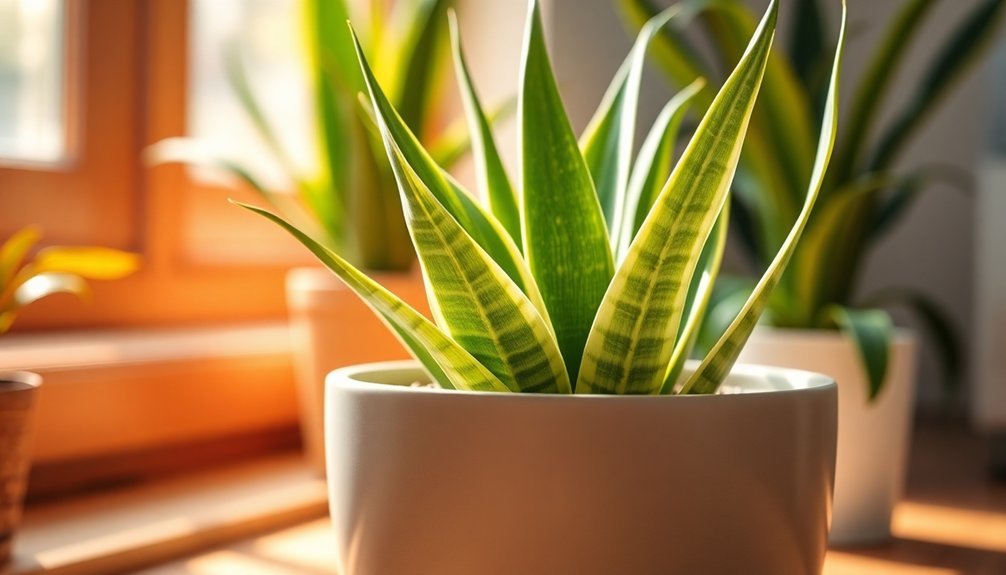
The Snake Plant stands as one of the most forgiving houseplants when it comes to light requirements. You'll find that these versatile indoor plants can thrive in almost any lighting condition, from low light corners to bright window spots.
Snake Plants adapt effortlessly to any light situation, making them perfect companions for both dim corners and sun-drenched windowsills.
While they adapt remarkably well to shaded areas, they won't complain about direct sunlight either.
What makes Snake Plants truly exceptional is their ability to maintain healthy growth while purifying your indoor air, regardless of where you place them.
They're not fussy about humidity levels, and they'll reward you with more vibrant foliage when exposed to brighter light.
If you're looking for plant needs that align with a busy lifestyle, you'll appreciate their drought-resistant nature.
Just remember that they prefer temperatures between 60°F and 80°F for ideal growth.
Spider Plant: Adapting From Medium to Indirect Light
While Spider Plants can handle various lighting situations, they reach their full potential in bright, indirect light conditions. You'll notice your plants thrive when they receive consistent, filtered sunlight, displaying lush foliage and vigorous growth.
If you're working with medium light levels in your indoor space, your Spider Plants will still survive, but expect slower growth rates. Watch for signs that your plant needs more light, such as elongated stems or smaller leaves. These indicators suggest it's time to relocate your plant to a brighter spot.
To guarantee healthy plant growth, rotate Spider Plants regularly, preventing them from leaning toward light sources. Though they're adaptable, avoid keeping them in low light for extended periods, as this can diminish their characteristic fullness and overall liveliness.
Peace Lily: Thriving in Low Light Settings
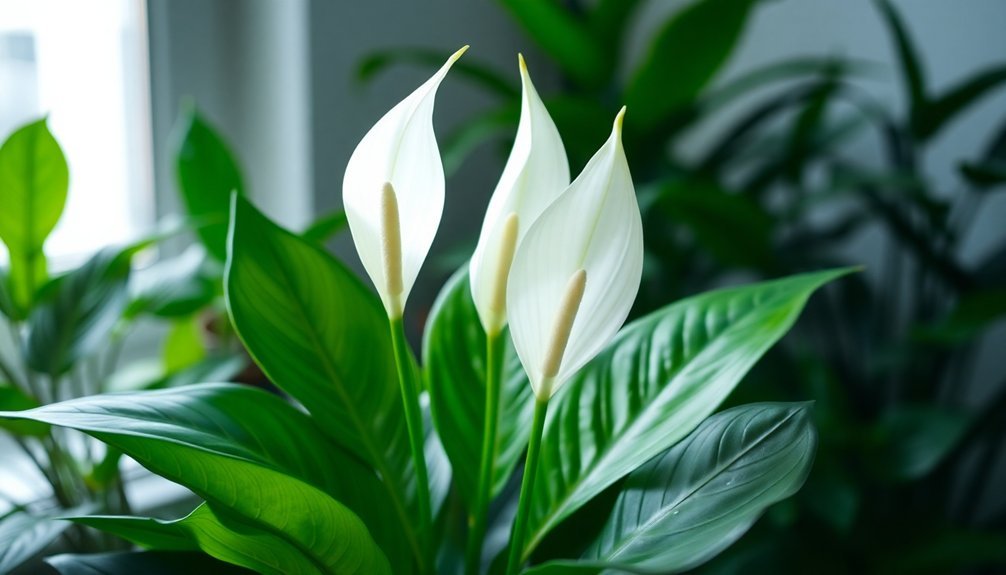
Peace Lilies make an excellent choice for your dimly lit spaces, as they'll flourish with minimal light exposure of just 5 to 10 foot-candles found in north-facing rooms or office environments.
You'll see ideal growth and more abundant blooms when you place them in bright, indirect light for 12 hours daily, though they can adapt well to artificial lighting conditions.
To prevent light-related issues like yellowing leaves and reduced flowering, you should rotate your Peace Lily periodically and watch for signs that it needs more exposure, especially if it starts leaning toward the light source.
Light Requirements and Placement
Among popular houseplants, Spathiphyllum (Peace Lily) stands out as a remarkable choice for low-light environments.
You'll find these adaptable plants thrive when placed at least seven feet from windows, and they can even flourish in spaces without natural light. While peace lilies tolerate bright indirect light, you'll need to protect them from direct sunlight to prevent leaf burn.
- Place your peace lily in low to medium light conditions, but expect fewer flowers in dimmer settings
- Monitor leaf color – yellowing leaves suggest insufficient light exposure
- Adjust placement if you notice reduced flowering or unhealthy foliage
To maintain ideal growth, regularly assess your peace lily's light requirements and modify its location accordingly.
You'll know you've found the sweet spot when your plant maintains healthy green foliage and produces its characteristic white blooms.
Growth in Artificial Light
Since artificial lighting has become increasingly common in modern spaces, you'll find that peace lilies adapt remarkably well to fluorescent and LED lighting conditions.
As one of the most versatile low-light plants, they only need 12-14 hours of light for plants to maintain healthy growth.
You can successfully grow these resilient foliage plants under various artificial lighting setups in offices or rooms with minimal natural light. Their efficient photosynthesis process means they'll thrive even when your light source isn't ideal.
However, you'll want to watch for yellowing leaves or decreased flowering, as these signs indicate your plant needs more light.
While peace lilies can flourish in low-light environments, providing a few hours of bright, indirect light will boost their growth and flowering potential.
Common Light-Related Issues
When it comes to light-related problems, understanding your peace lily's signals can prevent common growing issues. These resilient plants grow well in various light conditions, but they'll show clear signs when their light requirements aren't being met.
Watch for these common light-related issues:
- Yellowing leaves and lack of blooms indicate insufficient natural light
- Crispy, brown edges suggest too much direct sunlight exposure
- Leaning stems mean uneven light distribution
To help your peace lilies thrive, place them in bright, indirect light for ideal growth.
While they can tolerate low-light conditions, you'll notice slower growth in darker spaces. If you're using artificial light or have limited natural light, remember to rotate your plant regularly to guarantee even growth and prevent it from stretching toward the light source.
Golden Pothos: Versatile Light Requirements
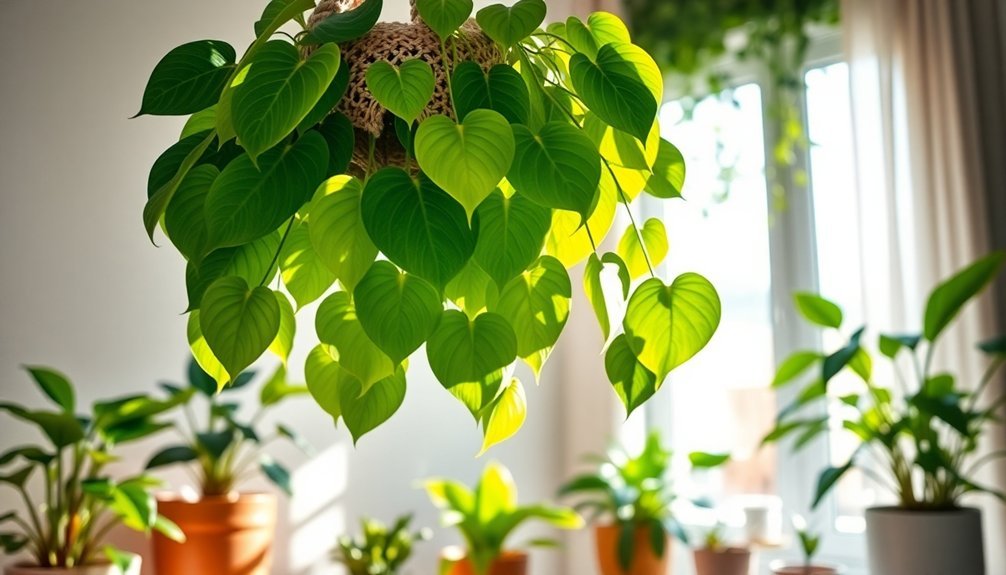
The Golden Pothos stands out as one of the most accommodating houseplants when it comes to light requirements. You'll find that this indoor plant can thrive in various light levels, from low to bright indirect light, making it perfect for nearly any spot in your home.
While plants can thrive in lower light conditions, you'll achieve ideal growth by providing a good amount of light in medium to bright indirect settings. This versatility doesn't mean you should place your Golden Pothos in direct sunlight, though – doing so can cause brown, crispy spots on the leaves.
As an added bonus, this adaptable house plant helps purify your indoor air while adjusting to different light conditions. Whether you're a novice or experienced gardener, you'll appreciate how easily this plant adapts to various lighting situations.
Chinese Evergreen: Perfect for Office Lighting
Much like the adaptable Golden Pothos, Chinese Evergreens have earned their reputation as office favorites thanks to their remarkable tolerance of indoor lighting conditions.
You'll find these low-maintenance indoor plants thriving even seven feet away from windows, making them perfect for office environments with limited natural light.
Chinese Evergreens offer multiple benefits that make them ideal for your workspace:
Chinese Evergreens transform any workspace into a healthier, more vibrant environment while demanding minimal attention from their busy caretakers.
- They're excellent air-purifying plants that actively improve your office's air quality
- You won't need to worry about strict watering schedules, as they can handle occasional lapses in consistent moisture
- Their diverse foliage patterns and colors enhance your office aesthetics without demanding bright light
With their ability to flourish in low light conditions and minimal care requirements, Chinese Evergreens are an excellent choice for busy professionals seeking to green their workspace.
ZZ Plant: Surviving in Minimal Light
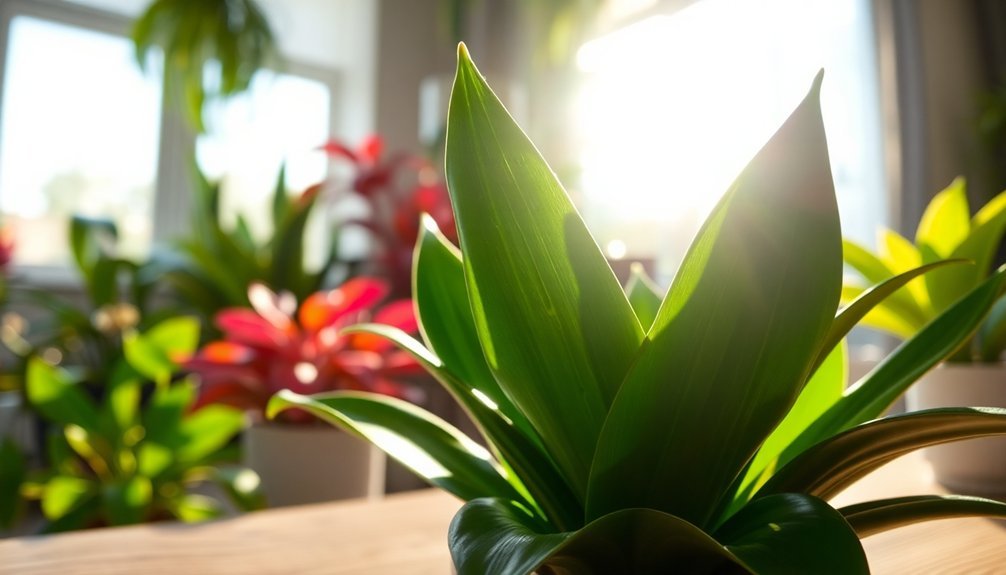
Known for thriving in even the darkest corners of your home, ZZ Plants have earned their reputation as the ultimate low-light survivors.
You'll find they're especially well-suited for North Facing windows or spaces with minimal natural light, where other plants struggle to survive.
What makes ZZ Plants truly remarkable is their incredible resilience and water storage capabilities.
Their thick, waxy leaves and rhizomes act like natural reservoirs, allowing them to withstand long periods without water.
While they can adapt to various settings, these plants thrive particularly well in low light conditions, managing to stay healthy in light levels as low as 50 lux.
You don't need to worry about placing them in direct light – they'll maintain their lush appearance and steady growth even in dim environments, making them perfect for challenging indoor spaces.
Monstera Deliciosa: Bright Indirect Light Expert
While many houseplants adapt to various light conditions, Monstera Deliciosa specifically demands bright indirect light to reach its full capability.
You'll find this stunning plant thrives best near an east facing window or west facing window, where it can soak up natural sunlight without direct exposure that could damage its iconic leaves.
To guarantee your Monstera Deliciosa gets the light it needs:
- Place it 3-6 feet from windows to maximize bright indirect light while avoiding leaf burn
- Assess the light quality seasonally and adjust its position as needed
- Consider grow lighting solutions during darker months to maintain peak growth
Frequently Asked Questions
What 7 Things Do Plants Need to Grow Indoors?
You'll need to provide your indoor plants with adequate light, consistent water, proper humidity, fertilizer, stable temperatures, well-draining soil, and good air circulation to guarantee they thrive in your home environment.
How Much Light Do Indoor House Plants Need?
You'll need to provide your indoor plants with 12-18 hours of daily light. Most thrive with either high light (6+ hours direct sun), medium light (indirect sun), or low light, depending on the species.
What Is the PPF for House Plants?
You'll find most house plants thrive with PPF levels between 50-400 µmol/m²/s. Low-light plants need 50-150 µmol/m²/s, while high-light plants require 400+ µmol/m²/s for ideal growth.
What Light Setting Is Best for Indoor Plants?
You'll want bright indirect light for most indoor plants. Place them near east-facing windows for gentle morning sun, or a few feet away from south-facing windows to avoid harsh direct sunlight.
In Summary
Choose from these seven resilient indoor plants to match your home's lighting conditions. Whether you're dealing with dim corners or bright spaces, you'll find the perfect plant companion. Start with low-maintenance options like the Snake Plant or ZZ Plant if you're new to indoor gardening. Remember, while these plants adapt well to various light levels, they'll still need consistent care to thrive in your space.

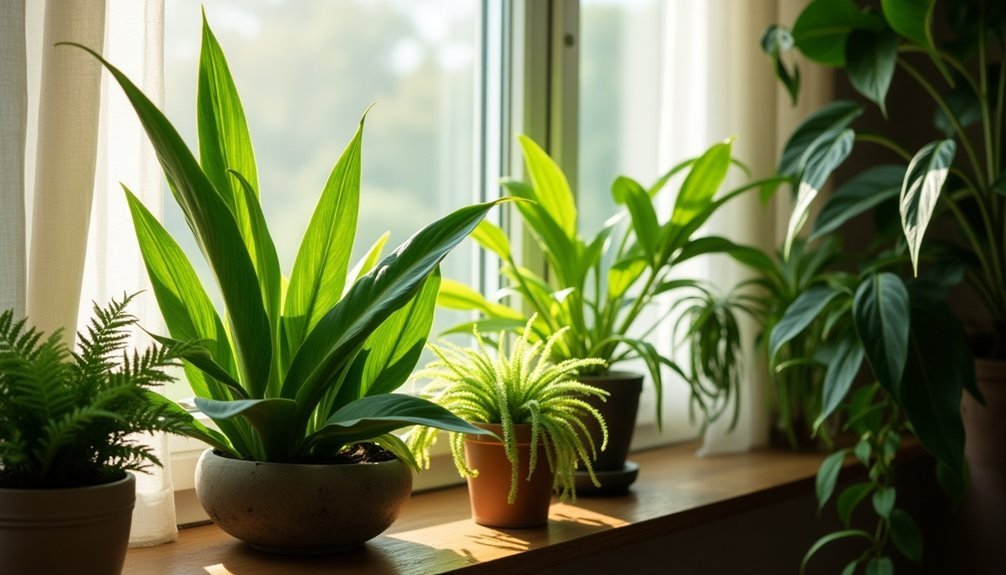



Leave a Reply